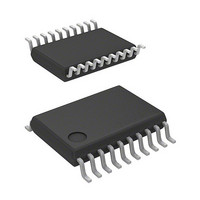R5F21324ANSP#U1 Renesas Electronics America, R5F21324ANSP#U1 Datasheet - Page 600

R5F21324ANSP#U1
Manufacturer Part Number
R5F21324ANSP#U1
Description
MCU 1KB FLASH 16K ROM 20-LSSOP
Manufacturer
Renesas Electronics America
Series
R8C/3x/32Ar
Datasheet
1.R5F21322ANSPU1.pdf
(629 pages)
Specifications of R5F21324ANSP#U1
Core Processor
R8C
Core Size
16/32-Bit
Speed
20MHz
Connectivity
I²C, LIN, SIO, SSU, UART/USART
Peripherals
POR, PWM, Voltage Detect, WDT
Number Of I /o
15
Program Memory Size
16KB (16K x 8)
Program Memory Type
FLASH
Ram Size
1.5K x 8
Voltage - Supply (vcc/vdd)
1.8 V ~ 5.5 V
Data Converters
A/D 4x10b
Oscillator Type
Internal
Operating Temperature
-20°C ~ 85°C
Package / Case
20-LSSOP
Lead Free Status / RoHS Status
Lead free / RoHS Compliant
Eeprom Size
-
Available stocks
Company
Part Number
Manufacturer
Quantity
Price
- Current page: 600 of 629
- Download datasheet (7Mb)
Under development
R8C/32A Group
REJ09B0458-0020 Rev.0.20
Page 570 of 583
33.11 Notes on Serial Interface (UART2)
33.11.1 Clock Synchronous Serial I/O Mode
33.11.1.1 Transmission/Reception
33.11.1.2 Transmission
33.11.1.3 Reception
When the RTS function is used with an external clock, the RTS2 pin outputs “L,” which informs the
transmitting side that the MCU is ready for a receive operation. The RTS2 pin outputs “H” when a receive
operation starts. Therefore, the transmit timing and receive timing can be synchronized by connecting the RTS2
pin to the CTS2 pin of the transmitting side. The RTS function is disabled when an internal clock is selected.
If an external clock is selected, the following conditions must be met while the external clock is held high when
the CKPOL bit in the U2C0 register is set to 0 (transmit data output at the falling edge and receive data input at
the rising edge of the transfer clock), or while the external clock is held low when the CKPOL bit is set to 1
(transmit data output at the rising edge and receive data input at the falling edge of the transfer clock).
•
•
•
In clock synchronous serial I/O mode, the shift clock is generated by activating the transmitter. Set the UART2-
associated registers for transmit operation even if the MCU is used for receive operation only. Dummy data is
output from the TXD2 pin while receiving.
When an internal clock is selected, the shift clock is generated by setting the TE bit in the U2C1 register to 1
(transmission enabled) and placing dummy data in the U2TB register. When an external clock is selected, set
the TE bit to 1 (transmission enabled), place dummy data in the U2TB register, and input an external clock to
the CLK2 pin to generate the shift clock.
If data is received consecutively, an overrun error occurs when the RE bit in the U2C1 register is set to 1 (data
present in the U2RB register) and the next receive data is received in the UART2 receive register. Then, the
OER bit in the U2RB register is set to 1 (overrun error). At this time, the U2RB register value is undefined. If an
overrun error occurs, the IR bit in the S2RIC register remains unchanged.
To receive data consecutively, set dummy data in the low-order byte in the U2TB register per each receive
operation.
If an external clock is selected, the following conditions must be met while the external clock is held high when
the CKPOL bit is set to 0, or while the external clock is held low when the CKPOL bit is set to 1.
•
•
•
The TE bit in the U2C1 register = 1 (transmission enabled)
The TI bit in the U2C1 register = 0 (data present in the U2TB register)
If the CTS function is selected, input on the CTS2 pin = “L”
The RE bit in the U2C1 register = 1 (reception enabled)
The TE bit in the U2C1 register = 1 (transmission enabled)
The TI bit in the U2C1 register = 0 (data present in the U2TB register)
Preliminary specification
Specifications in this manual are tentative and subject to change.
Nov 05, 2008
33. Usage Notes
Related parts for R5F21324ANSP#U1
Image
Part Number
Description
Manufacturer
Datasheet
Request
R

Part Number:
Description:
KIT STARTER FOR M16C/29
Manufacturer:
Renesas Electronics America
Datasheet:

Part Number:
Description:
KIT STARTER FOR R8C/2D
Manufacturer:
Renesas Electronics America
Datasheet:

Part Number:
Description:
R0K33062P STARTER KIT
Manufacturer:
Renesas Electronics America
Datasheet:

Part Number:
Description:
KIT STARTER FOR R8C/23 E8A
Manufacturer:
Renesas Electronics America
Datasheet:

Part Number:
Description:
KIT STARTER FOR R8C/25
Manufacturer:
Renesas Electronics America
Datasheet:

Part Number:
Description:
KIT STARTER H8S2456 SHARPE DSPLY
Manufacturer:
Renesas Electronics America
Datasheet:

Part Number:
Description:
KIT STARTER FOR R8C38C
Manufacturer:
Renesas Electronics America
Datasheet:

Part Number:
Description:
KIT STARTER FOR R8C35C
Manufacturer:
Renesas Electronics America
Datasheet:

Part Number:
Description:
KIT STARTER FOR R8CL3AC+LCD APPS
Manufacturer:
Renesas Electronics America
Datasheet:

Part Number:
Description:
KIT STARTER FOR RX610
Manufacturer:
Renesas Electronics America
Datasheet:

Part Number:
Description:
KIT STARTER FOR R32C/118
Manufacturer:
Renesas Electronics America
Datasheet:

Part Number:
Description:
KIT DEV RSK-R8C/26-29
Manufacturer:
Renesas Electronics America
Datasheet:

Part Number:
Description:
KIT STARTER FOR SH7124
Manufacturer:
Renesas Electronics America
Datasheet:

Part Number:
Description:
KIT STARTER FOR H8SX/1622
Manufacturer:
Renesas Electronics America
Datasheet:

Part Number:
Description:
KIT DEV FOR SH7203
Manufacturer:
Renesas Electronics America
Datasheet:











